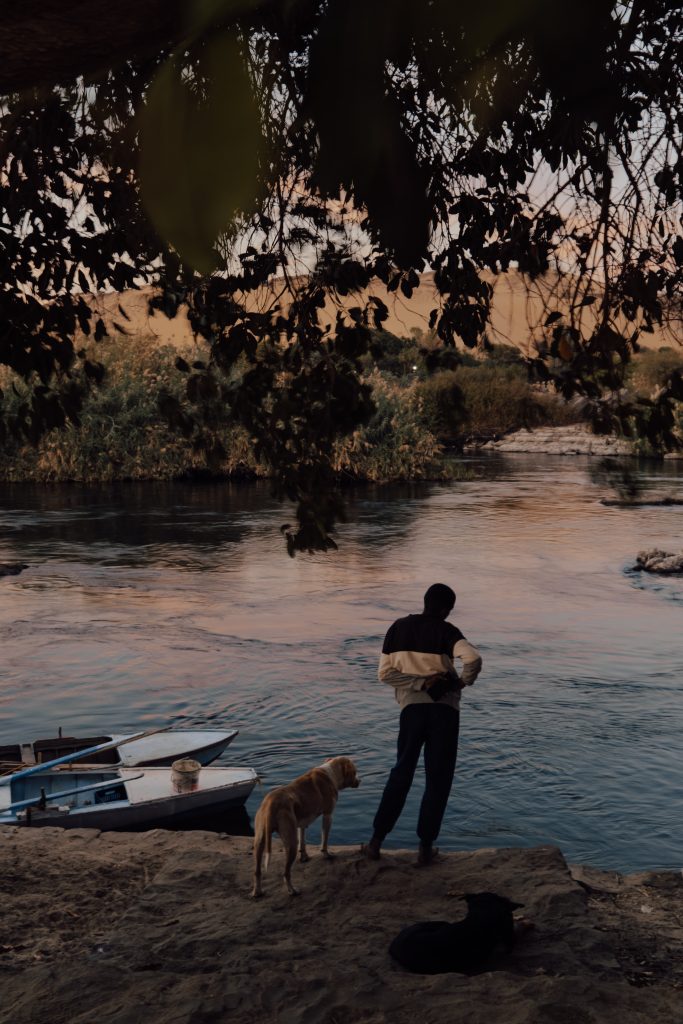For the past three years, photographer Diana Smykova has quietly carved out a space within Egypt’s visual narrative — a space that listens more than it interrupts, watches more than it imposes. Her work is not the sweeping, exoticizing lens so often turned on North Africa, but an intimate, human-centered gaze rooted in lived encounters, myth, memory, and the politics of place. Her most recent photographs, made along the banks of the Nile River and deep within the Sinai Peninsula, form a quietly radical body of work: portraits, landscapes, and interior studies that weave together folklore, displacement, and the resilience of everyday life.
While traveling by felucca — a traditional wooden boat — through Aswan and its neighboring Nubian villages, Smykova became fascinated by a local belief in the People of the Nile, an unseen race inhabiting a mirror-world beneath the river. “Only those with a pure heart and soul can see them,” a man told her in Aswan.
One particularly haunting story came from an elderly woman who spoke of a long-ago love affair with one of these beings. On the first day of Eid, she met a man who seemed both earthly and otherworldly. The love that followed was intense, but fear of the unknown — and of forsaking her own family — kept her anchored in the upper world. Years later, on her wedding day, she dressed her human groom in the keffiyeh and galabeya of her lost love, attempting to weave her two worlds together.



The image of the solitary camel tethered beside a crumbling wall, framed by the harsh Sinai mountains, echoes these myths. It hints at the intersection between tradition and rupture — a creature of the old world standing beside the modern detritus of satellite dishes and plastic containers, in a landscape permanently reshaped by the forces of modernity.
Smykova’s work also revisits the social aftermath of the Aswan High Dam, whose construction submerged hundreds of ancestral Nubian villages beneath Lake Nasser in the 1960s. The tahjir — Arabic for displacement — forced thousands to resettle in poorly planned villages on barren lands, severing centuries-old ties to the fertile banks of the Nile. Her portraits capture this lingering fracture. The young woman leaning against her knees, a chipped enamel teapot before her, speaks volumes of weariness and waiting. The makeshift homes of these resettled communities are both fragile shelters and resistant acts of survival.



The journey continues because, In Sinai, Smykova turned her lens on the Jabaliya and Tarabin tribes, communities deeply embedded in the mountains and deserts of Saint Catherine, Dahab, and Nuweiba. The photographs from this region convey both vastness and intimacy — the desert’s intimidating scale counterbalanced by human rituals of rest, gathering, and storytelling.
One portrait in particular — of a Bedouin man reclined against patterned cushions, a cigarette poised at his lips, gaze steady and unyielding — is emblematic of Smykova’s approach. It resists stereotypes. There’s no dramatization of desert life, no quest for exoticism. Instead, it is an image of presence: a man occupying his world on his own terms.


These are not images that claim to “capture” a place or a people. They witness. They honor oral histories, like the Nubian woman’s submerged love story, and trace the unseen afterlives of state-driven modernization projects. Her photography holds space for myth, displacement, and the small, sustaining rituals of daily survival — tea poured slowly, conversations beneath red tent cloth, and the endless cycle of leaving and returning.
In an Egypt often photographed from the outside looking in, Smykova’s work feels like a conversation you’re lucky to be invited into.





